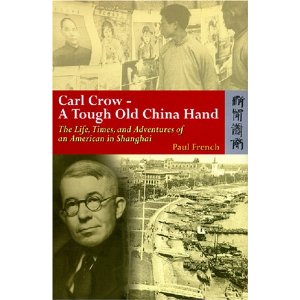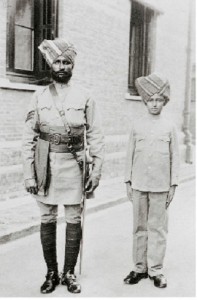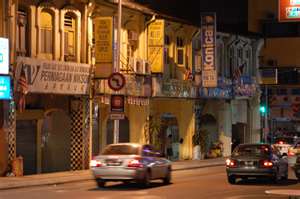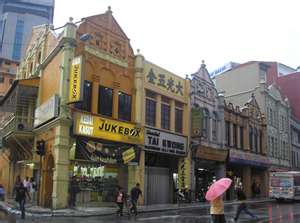Posted: April 14th, 2012 | No Comments »
By 1941 things were starting to look a little dire in the Shanghai International Settlement as the Japanese encircled and supplies ran low while distribution was disrupted – the “solitary island” period. So naturally the Shanghai Power Company in 1941 needed to start looking at way to reduce electricity use, even as the nightclubs and cabarets carried on….nice that you could get a representative to come round and talk to you about power efficiency! Trying getting that kind of service today!

Posted: April 13th, 2012 | No Comments »
RAS LECTURE
Tuesday 17th April 2012 at 7.00pm
The Tavern, Radisson Blu Plaza Xingguo Hotel 78 Xingguo Road,Shanghai
兴国宾馆上海市兴国路78å·
SHELLY BRYANT
ON
A Living Art Form: The Making of a Classical Chinese Garden

The Suzhou garden stands as the pinnacle of Chinese culture and refinement – a blend of the visual arts, philosophy and literature in the confines of a small physical space. Thus, to stroll through a Chinese garden is to immerse oneself in an elite expression of traditional Chinese culture. In contrast to the northern imperial gardens, the southern approach to landscaping that originated from the city of Suzhou and the surrounding area emphasizes poetry and art in a living space. “A Living Art Form: The Making of a Chinese Garden” will explore the rich traditions of Suzhou gardening that stretch back to the distant past, with the first private garden in Suzhou having belonged to the Wu Emperor in the Spring and Autumn period (600 BC). The construction of these leisure grounds culminated between the 16th and 18th centuries, when there were over 200 private gardens in Suzhou. The lecture will highlight the underlying philosophy of garden construction and explore the various techniques that have been used to bring that philosophy to life within the grounds of the classical Suzhou garden.
Shelly Bryant divides her year between Shanghai and Singapore, working as a teacher, writer, researcher and translator. She is the author of two volumes of poetry, Cyborg Chimera and Under the Ash, and a travel guide to Suzhou entitled Suzhou Basics. Her third volume of poetry, Voices of the Elders, and her travel memoir The End of the Line are slated for release in early 2012. Her most recent projects include writing an updated guide to the city of Shanghai for Urbanatomy and translating Sheng Keyi’s novel Northern Girls (北妹) for Penguin Books.
Shelly’s poetry has appeared in journals, magazines and websites around the world, as well as in several Shanghai-based art exhibitions, including dark ’til dawn, Things Disappear, and Studio White * Exhibition 2011.
Entrance: RMB 30.00 (RAS members) and RMB 80.00 (non-members). Those unable to make the donation but wishing to attend may contact us for exemption, prior to the RAS Lecture. Membership applications and membership renewals will be available at this event. Members will have priority booking until 14th April 2012.
To RSVP:Â Please “Reply” to this email or write to
RAS Bookings at: bookings@royalasiaticsociety.org.cn
Posted: April 12th, 2012 | 1 Comment »
There is a chap in California somewhere by the name of Laszlo Montgomery who runs a website that issues podcasts he records on Chinese history – The China History Podcast. He covers topics and subjects old and new and, I’m delighted to discover, has just done a podcast on the life of Carl Crow – my great hero and who’s biography I penned some years back (Carl Crow – A Tough Old China Hand). I must say that for anyone not feeling inclined to read my biography (and shame on you for such thoughts!!) Mr Montgomery does a most excellent summation of Carl’s life and major exploits. Well worth tuning in to – not just for Crow obviously but for his previous podcasts too.

Posted: April 11th, 2012 | 1 Comment »
Drunk and brawling sailors, pimps, standovermen and gangsters along with forgers, fences and good old fashioned burglars, not forgetting the odd murderer, rapist and stone cold killer – in 1907 in Shanghai this is where they ended up – The Shanghai Municipal Gaol complete with its own staff quarters and go-down for its stores. To be fair, in 1907, around the world there were quite a few worse prisons to get sent to!

Posted: April 10th, 2012 | No Comments »
RAS WEEKENDER
Saturday 14th April 2012 at 4.00pm
Tavern, Radisson Plaza Xingguo Hotel 78 Xing Guo Road, Shanghai
PROFESSOR ROBERT BICKERS
ON
Britain, China and India 1830s – 1947

British China was, in origin, an off-shoot of British India. Most notoriously, it was the prime market for Indian opium, and a key factor in British Indian revenues through the tea trade. This talk explores the history of this triangular relationship, and the ways in which the British story in China was shaped by its Indian roots and connections. The Indian factor remained a live and important one until the end of the treaty era in the 1940s, and remained prominent in Hong Kong after the establishment of the PRC. While Sir Victor Sassoon charmed the city’s elite, Sikhs policed China’s two international settlements and several British concessions. British Indian forces were deployed four times on active service to protect the British establishment as it promenaded to tiffin along its bunds. Britons besieged at Peking in 1900 chatted about the parallels with Lucknow in 1857. Where precisely did the British in China think they actually were?
Robert Bickers is Professor of History at the University of Bristol, and the author of Empire Made Me: An Englishman Adrift in Shanghai (2003) and The Scramble for China: Foreign Devils in the Qing Empire (2011, just published in paperback). He has recently contributed a new foreword to the Earnshaw Books reprint of E.W. Peters’ Shanghai Policeman, and is preparing a new work on China’s coastal lighthouses.
Entrance: RMB 80.00 (RAS members) and RMB 130.00 (non-members). Those unable to make the donation but wishing to attend may contact us for exemption, prior to the RAS Weekender event. Membership applications and membership renewals will be available at this event.
RSVP: “Reply” to this email or to RAS Bookings at: bookings@royalasiaticsociety.org.cn
Posted: April 9th, 2012 | No Comments »
I pass through KL a couple of times a year. The city has given itself over to the car almost entirely now and so any advance in public transport is not only welcome to those of us who find cars dreary and boring but also essential if the city is not to descend into gridlocked chaos and choking asthma filled skies. Malaysia’s MRT Corp is building some public transport – light rail and there are developments in KL’s Chinatown. Preservationists were worried that expanding the light rail around Jalan Tun Tan Cheng Lock might damage, or see the destruction of, some old buildings – specifically some old shophouses in Jalan Sultan above a planned tunnel. However, MRT Corp has insisted that it can build the tunnel and preserve the shophouses.
I hope this is the case as KL should learn from Singapore. Singapore nearly lost all its old shophouses but managed just before knocking them all down that they were of value. KL Chinatown without shophouses would be a slightly odd thing.

Jalan Sultan shophouses
 Jalan Tun Tan Cheng Lock shophouses
Jalan Tun Tan Cheng Lock shophouses
Posted: April 7th, 2012 | No Comments »
Katya Knyazeva is one of the smartest and most diligent people around in the Shanghai heritage “movement” (such as it is). She is very good particularly on the old town and its ongoing destruction which, given that that now includes some of the oldest Chinese style structures in Shanghai, is particularly shocking. For years we’ve heard officials blithely disregard the destruction of western style structures as unimportant – “colonial”, “imperialist” and therefore embarrassing for them and so to be swept away, but these arguments were always straw men to cover for their vandalism-for-profit and philistinism. The destruction of ancient Chinese culture in Nantao is obviously harder to explain away and so largely they just let places rot away until they fall down. Here, in Time Out Shanghai, Katya takes a tour round some of the most vulnerable buildings in old town and the long running dispute over the preservation of the Nie’s Garden compound in Yangpu (Yangtszepoo). Fascinating but tragic…
Posted: April 6th, 2012 | No Comments »
It’s been a while since I read Emily “Mickey” Hahn’s story of sin and salvation in the brothels of the wartime Orient (mostly in Shanghai) Miss Jill (originally published 1947). Jill doesn’t stand a chance – a drunk Aussie mum, taken in and lured to Shanghai by a dodgy Japanese count, sold into the bordello of Madame Antoinette on the Tibet Road (Xizang Road now but not a stone’s throw from the old “Line” of bordellos on Kiangse Road/Jiangxi Road). She then meets a good looking American journalist. It’s not a great book (in fact to be fair Mickey Hahn never wrote a great book – but most were fair enough) and it doesn’t have the touch of a Somerset Maugham or a Graham Greene, either of whom would have plumbed the depths of the characters psyches more ably than Hahn and would have rendered a better Shanghai too. Though from a technical point Hahn knew her Shanghai and renders it well here. There are those Shanghailanders and China Hands who worship the ground Hahn walked on – I’m not one of them; I like her of course, probably would have fancied her something rotten had I been knocking around in Shanghai at the time but, apart from her excellent New Yorker pieces, her output was fair-to-middling at best to be honest.
Still, here’s a cover of an edition of Miss Jill I picked up recently – a mass market paperback from America’s Avon put out in 1950. “A Beautiful Girl’s Story of SAlvation and Sin in the Orient” and, on the back, Miss Hahn herself, “Of all the cities of the world, it (Shanghai) is the town for me.” Indeed so….










